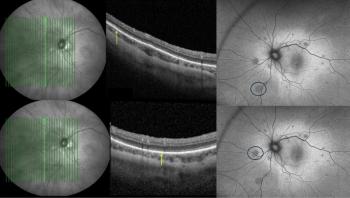
European Commission approves brolucizumab 6 mg for treatment of diabetic macular oedema
Approval is based on year 1 data from the Phase III KESTREL and KITE trials investigating brolucizumab 6 mg versus aflibercept 2 mg in DMO patients.
Novartis this week announced that the European Commission (EC) has approved brolucizumab 6 mg (Beovu) for the treatment of visual impairment due to diabetic macular oedema (DMO).
The approval in DMO represents the second indication for Beovu granted by the EC, which was first approved for the treatment of wet age-related macular degeneration in 2020.1 The EC decision applies to all 27 European Union (EU) member states as well as Iceland, Norway and Liechtenstein.
The EC approval was based on year one data from the Phase III, randomly assigned, double-masked KESTREL and KITE studies, which met their primary endpoint of non-inferiority in change in best-corrected visual acuity (BCVA) from baseline versus aflibercept at year one.2 In both trials, 2 following the loading phase, over half of patients (55.1% in KESTREL and 50.3% in KITE) in the Beovu 6 mg arm remained on a 12-week dosing interval through year 12. Aflibercept dosing was aligned to the approved EU label in year 1 of treatment.2,4 In aggregate, a numerically lower proportion of patient eyes treated with Beovu had intraretinal fluid, subretinal fluid or both at week 52 versus eyes treated with aflibercept (in KESTREL 60.3% in Beovu arm versus 73.3% in aflibercept arm; in KITE 54.2% versus 72.9%, respectively; testing for statistical significance was not performed).2
Per the approved prescribing information, following the loading phase of five doses injected 6 weeks apart, physicians may individualize treatment for DMO patients based on their disease activity, as assessed by vision and fluid-related parameters.3 In patients without disease activity, physicians should consider 12-week intervals between Beovu treatments; in patients with disease activity, physicians should consider 8-week intervals between treatments.3
“This approval marks a significant milestone for DMO patients, many of whom are of working age and struggle with adherence due to the need to manage multiple comorbidities related to diabetes,” said Jill Hopkins, senior vice president and Global Development Unit Head, Ophthalmology, Novartis Pharmaceuticals. “KESTREL and KITE were the first pivotal trials to assess an anti-VEGF on 6-week dosing intervals in the loading phase, suggesting Beovu may offer fewer injections from the start of treatment through year 1. The EC approval of Beovu in DMO may thus help address unmet needs.”
The most common ocular and non-ocular adverse events (≥ 5%) at year 1 in KESTREL and KITE were conjunctival hemorrhage, nasopharyngitis and hypertension.2 Intraocular inflammation (IOI) rates in KESTREL were 4.7% for brolucizumab 3 mg (including 1.6% retinal vasculitis), 3.7% for Beovu 6 mg (including 0.5% retinal vasculitis), and 0.5% for aflibercept 2 mg.2 IOI rates in KITE were equivalent (1.7%) between the Beovu 6 mg and aflibercept 2 mg arms with no retinal vasculitis reported.2 Retinal vascular occlusion was reported in KESTREL for brolucizumab 3 mg (1.1%) and 6 mg (0.5%), and in KITE for brolucizumab and aflibercept (0.6% each).2 The majority of these events were manageable and resolved with routine clinical care.2
In KESTREL, the percentage of patients who experienced ≥ 15 letter loss from baseline at year 1 was 1.6% for brolucizumab 3 mg, 0% for Beovu 6 mg and 0.5% for aflibercept.2 In KITE, the percentage of patients who experienced ≥ 15 letter loss from baseline at year one was 1.1% for Beovu 6 mg and 1.7% for aflibercept.2 Brolucizumab 6 mg is the commercialized dose of Beovu.3
Novartis said in the news release it remains committed to bringing Beovu to the patients who may benefit from this important medicine. Regulatory applications for Beovu in DMO are under review by the U.S. Food and Drug Administration (FDA) and the Japanese Pharmaceuticals and Medical Devices Agency (PMDA). Discussions with additional health authorities regarding Beovu are ongoing.
According to Novartis, aflibercept dosing was aligned to the approved EU label in year 1 of treatment.
KESTREL and KITE clinical trials
KESTREL and KITE are global, randomly assigned, double-masked, Phase III, two-year studies comparing the safety and efficacy of Beovu and aflibercept in the treatment of patients with visual impairment due to DMO.5,6
KESTREL and KITE involved 926 total patients in 36 countries. In the loading phase of both trials, patients in the Beovu arms were treated every 6 weeks for a total of 5 doses; patients in the aflibercept arms were treated every 4 weeks for a total of 5 doses, in line with its label.5,6 In the first year of the study, following the loading phase, patients in the Beovu arms were subsequently treated every 12 weeks, with those demonstrating disease activity moved to dosing every eight weeks.5,6 After the loading phase, patients in the aflibercept arms were treated every eight weeks.5,6
References
1. Romero-Aroca P. Managing diabetic macular edema: The leading cause of diabetes blindness. World J Diabetes. 2011;2(6):98-104.
2. Brown D, Wolf S, Garweg JG, et al. Brolucizumab for the treatment of visual impairment due to diabetic macular edema: 52-week results from the KESTREL & KITE studies. Presented at: The Association for Research in Vision and Ophthalmology (ARVO) 2021 Annual Meeting. May 2021.
3. Beovu [summary of product characteristics] Basel, Switzerland. Novartis: 2020.
4. Eylea [summary of product characteristics] Berlin, Germany. Bayer AG: 2014.
5. Data on file. KESTREL clinical trial protocol (CRTH258B2301). Novartis, 2021.
6. Data on file. KITE clinical trial protocol (CRTH258B2302). Novartis, 2021.
Newsletter
Get the essential updates shaping the future of pharma manufacturing and compliance—subscribe today to Pharmaceutical Technology and never miss a breakthrough.













































